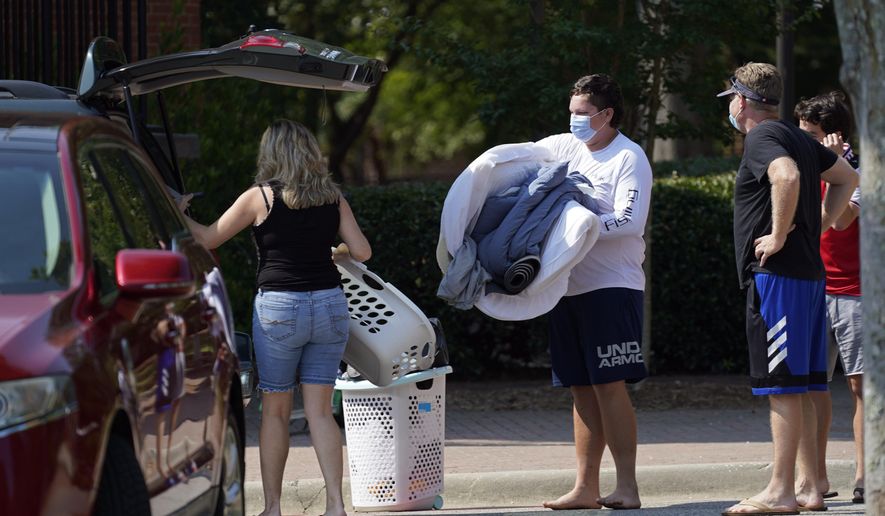RALEIGH, N.C. (AP) - At least 3,000 college students in North Carolina have tested positive for the coronavirus since campuses reopened last month for in-person classes, with an overwhelming number of cases coming from just three campuses, an Associated Press analysis shows.
The University of North Carolina at Chapel Hill has seen 895 students test positive for the virus since classes began Aug. 10, while North Carolina State University has reported 788 cases among students over the same time period. East Carolina University, which started classes Aug. 10, has had 756 students test positive since Aug. 9.
The 13 remaining public colleges within the University of North Carolina System and the group of 36 independent universities in the state have reported about 550 cases, combined.
Oyeronke Popoola, a 17-year-old freshman at UNC-Chapel Hill who moved out of campus and back to her home in Raleigh just eight days after classes started, thought more campuses would have decided to shut down and follow in UNC’s footsteps.
“I think they should all just make everything online,” Popoola said.
In the week before classes, 2.8% of coronavirus tests came back positive at UNC. But in the three weeks since classes reopened, 26.2% of tests came back positive, which is much higher than the state average that held steady between 6% and 8% throughout August.
The spike in cases prompted UNC, N.C. State and ECU to halt undergraduate in-person classes and move students out of their dorms as classes go fully online. While a handful of private universities began the academic year with online-only instruction, the vast majority of campuses remain undeterred in their efforts to have classes at least partially in person.
Laura Comino, a senior at UNC-Greensboro, said she’s pleased her college has not seen as sizable a spike as UNC. Classes at UNCG began Aug. 18. Just 24 students tested positive for the virus since Aug. 17, according to the university’s COVID dashboard.
Still, she wishes classes would have gone online-only from the beginning.
“The situation is so delicate that here is no real way that I see us making it the entire semester,” Comino said. “Now, we might. If we truly are careful and continue the way we are, we just might make it. But I don’t know. I can’t be comfortable. It feels kind of like being an intruder on campus right now because it truly does feel like we shouldn’t be here. It feels like a bomb waiting to explode.”
Adding to the uncertainty is the tremendous disparity in transparency universities are displaying. Some colleges do not provide the public with any information about COVID-19 cases, while others offer weekly updates with minimal details.
Shaw University said it is working to develop a coronavirus dashboard with statistics on cases, but confirmed there have been no positive student cases since fall classes began.
High Point University lists the number of active cases on its website, but a spokesperson declined to provide additional information about the number of positive cases among students since classes resumed. Several other private colleges did not immediately respond to requests for such information.
East Carolina University and Duke University publicly release comprehensive information about testing and caseloads, but do so on a weekly basis.
At UNC-Asheville, case counts do not distinguish between students and employees. North Carolina Central University makes the distinction but only discloses a cumulative number of positive cases going back to July 1 instead of the start of the school year.
The state’s top public health official, Mandy Cohen, said in an Aug. 19 news conference that the Department of Health and Human Services has worked behind the scenes with chancellors to draft plans on how to keep campus communities safe in the middle of a pandemic. Still, she is limited on what she can require of public and private colleges.
“There are certain things that we at the department have requirements about by law that folks must report to us in terms of cases,” Cohen said. “That is the case for K-12 schools. They are required when they have a cluster to report to us. That’s not the case at universities and colleges.”
___
Follow Anderson on Twitter at https://twitter.com/BryanRAnderson.
___
Follow AP coverage of the pandemic at https://apnews.com/VirusOutbreak and https://apnews.com/UnderstandingtheOutbreak.
___
Anderson is a corps member for the Associated Press/Report for America Statehouse News Initiative. Report for America is a nonprofit national service program that places journalists in local newsrooms to report on undercovered issues.




Please read our comment policy before commenting.